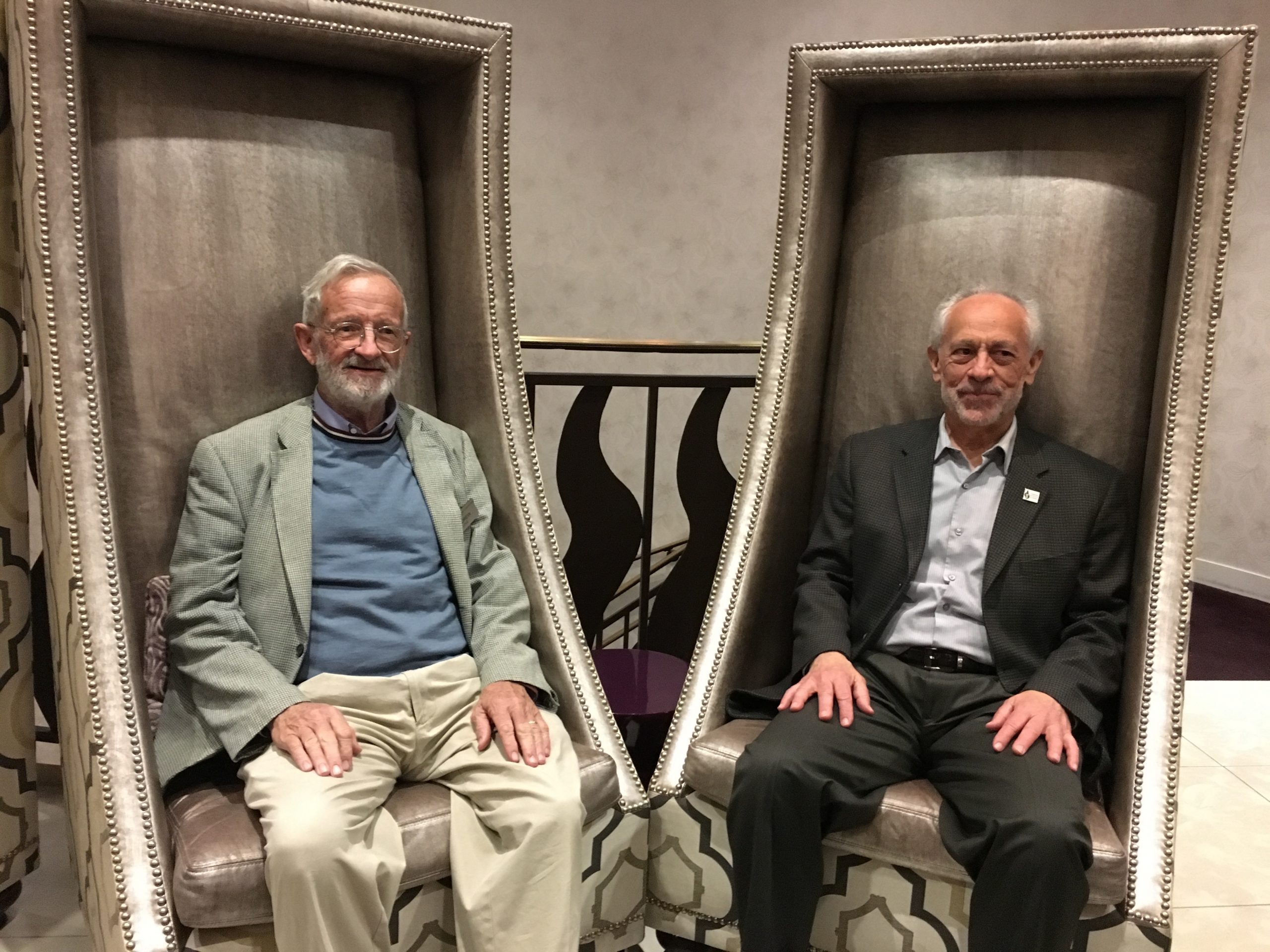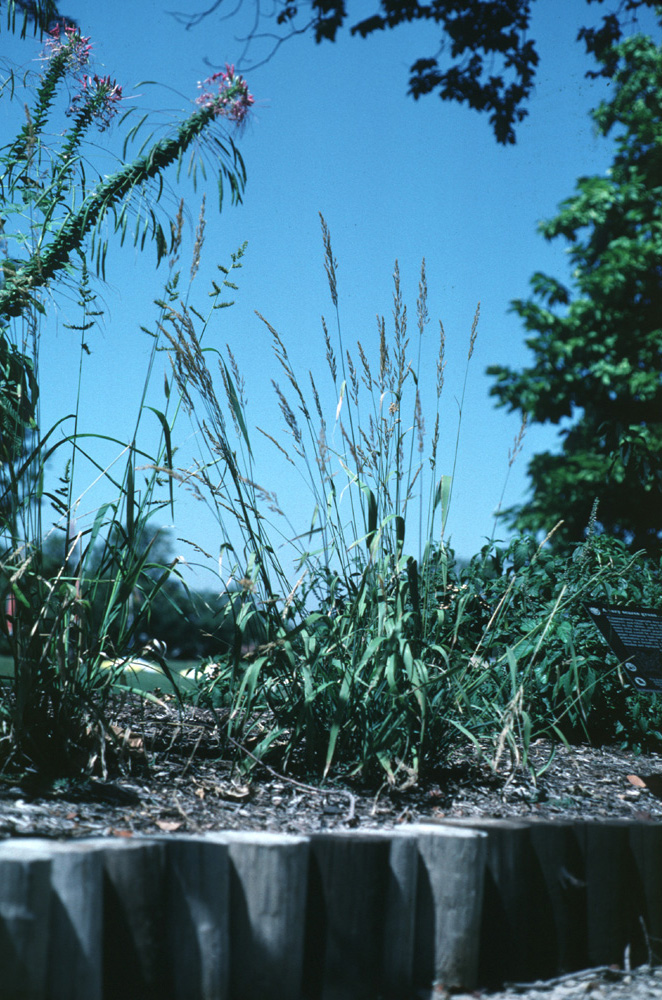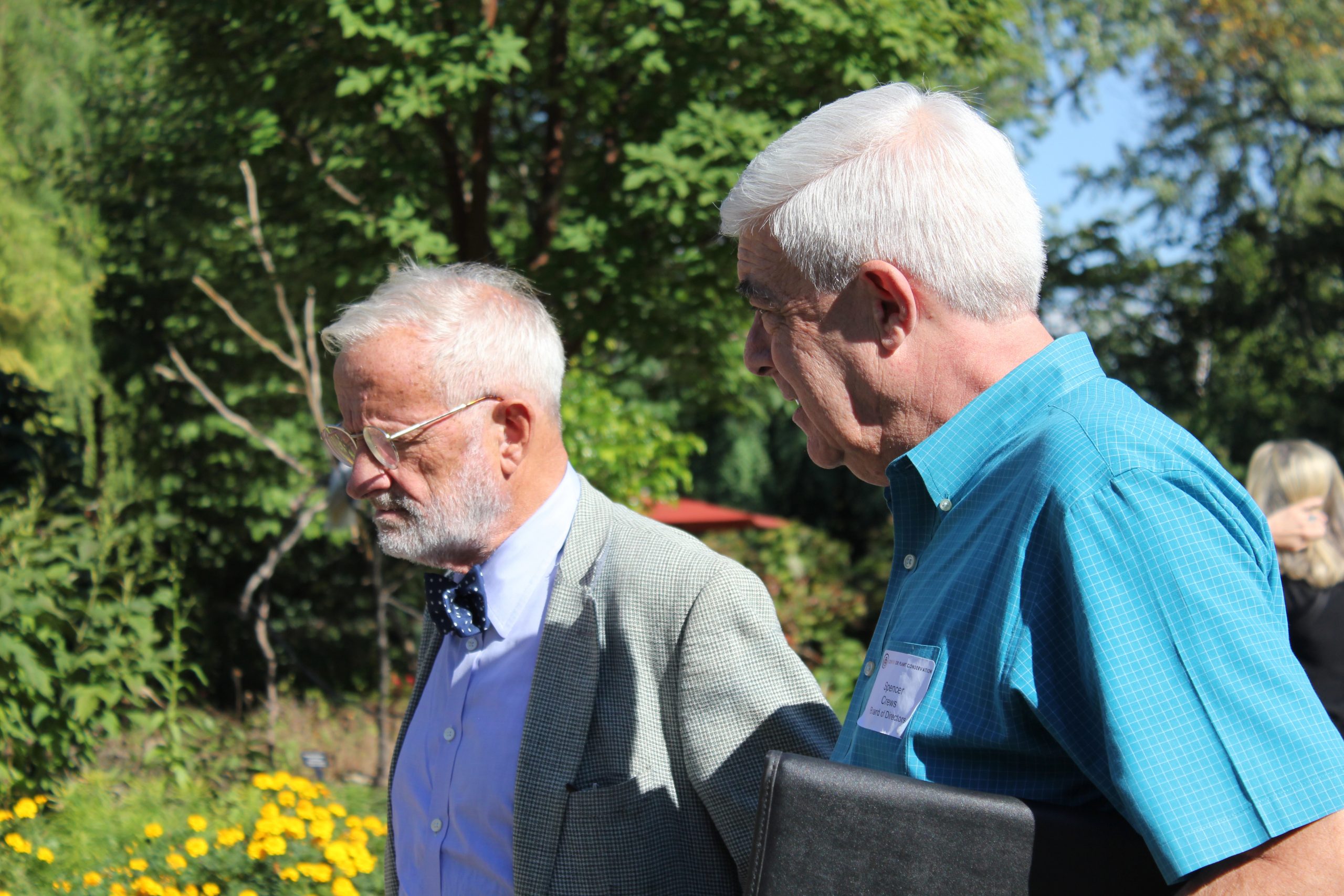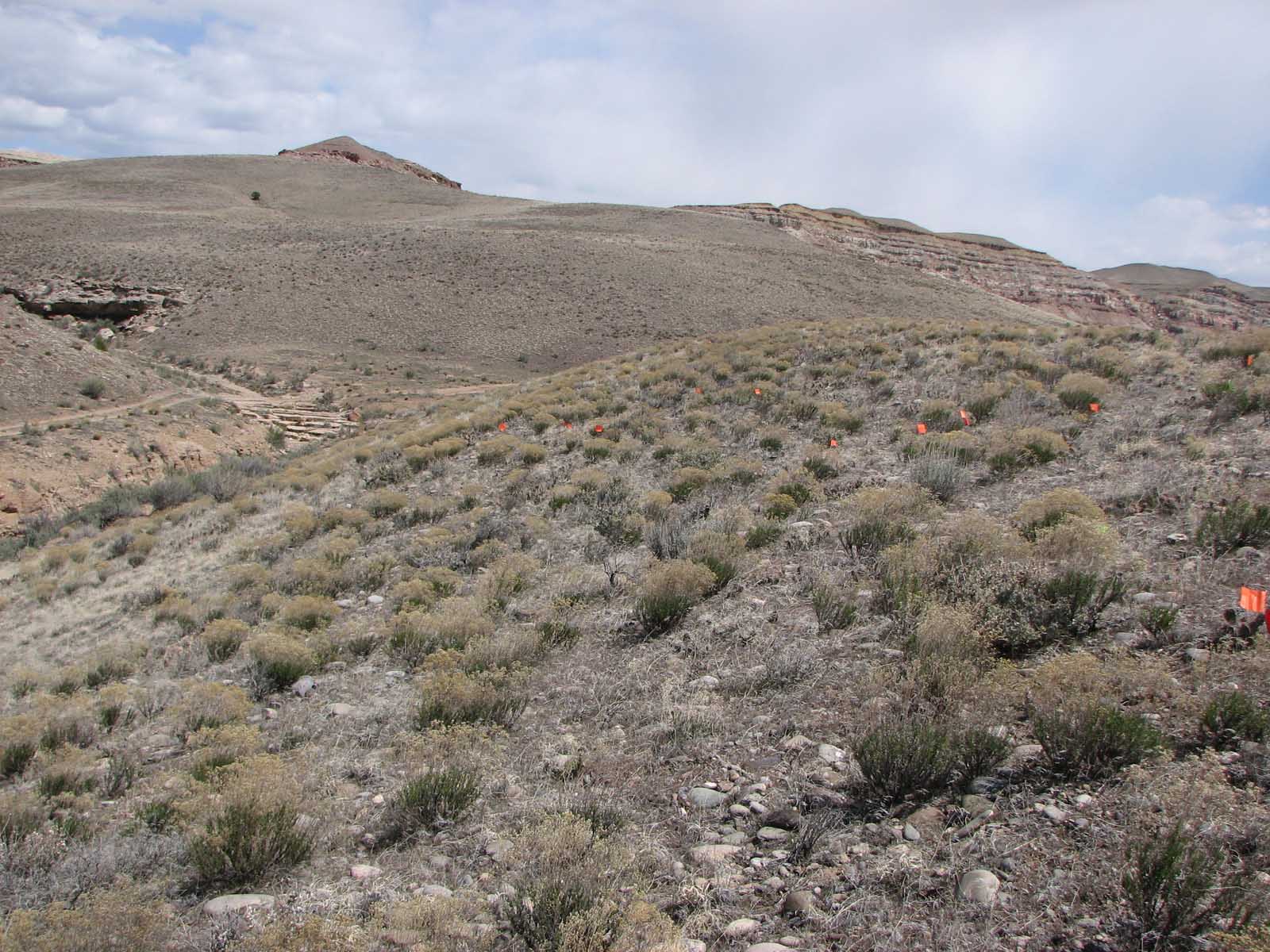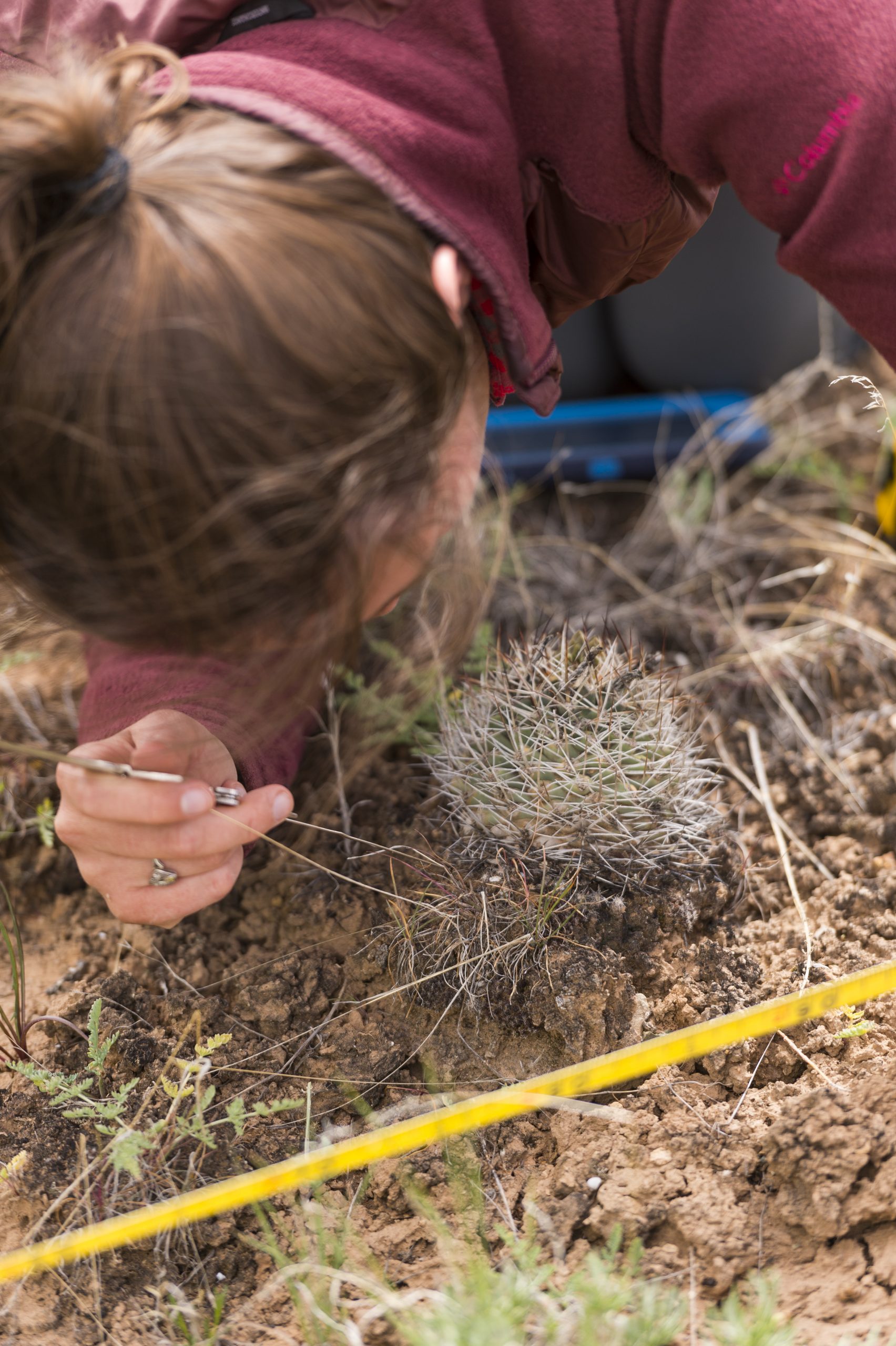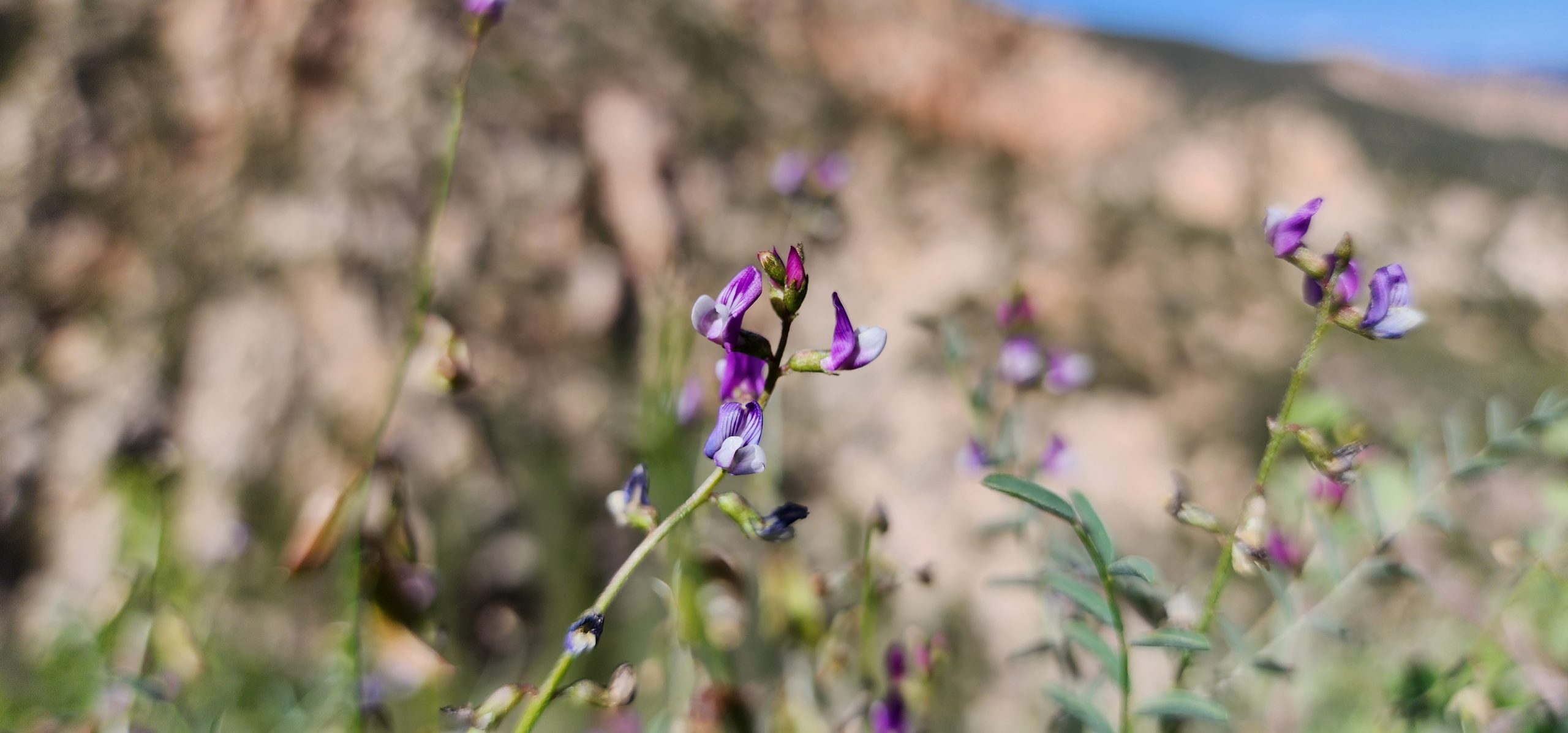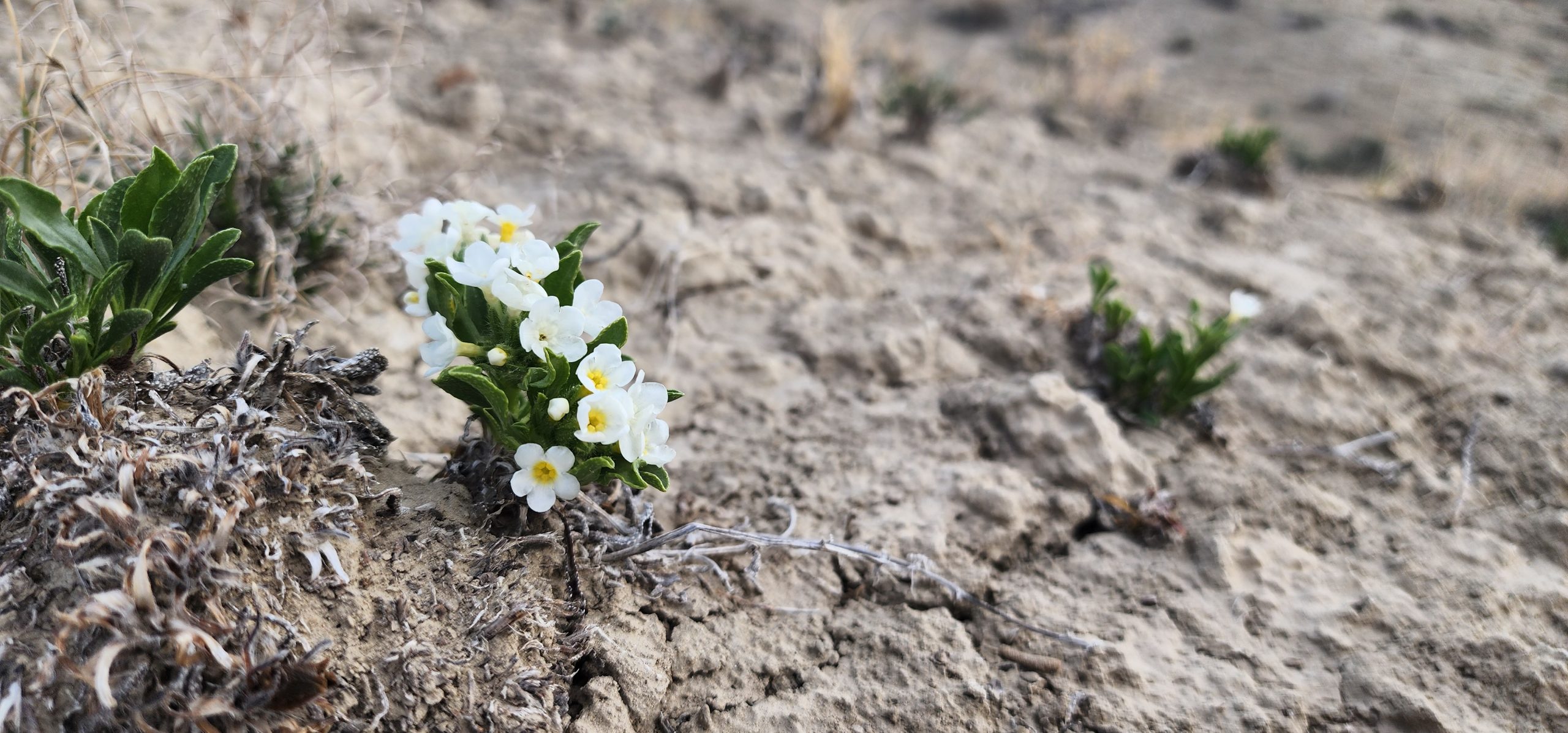Save Plants
CENTER FOR PLANT CONSERVATION
February 2022 Newsletter
One of the very special things about the Center for Plant Conservation is our deep understanding that saving plants from extinction requires a long-term commitment. Any conservation officer can tell you tales of trials and tribulations along the journey of helping a rare plant species survive. When the trials one day bear fruit, we sing about the joy we feel when we finally make a sound collection of some elusive rare species, or spy roots emerging after unlocking the mystery of germination, or see seedlings growing near a rare plant we reintroduced to the wild. The knowledge that saving a rare plant species from extinction takes time, resources, and dedication led CPC to create the Plant Sponsorship Program. Plant sponsorships offset some of the expenses of collecting, growing, and researching these species. Plant sponsorships provide the PI responsible for the named species with steady, reliable funding for the long-term work. A sponsorship does not cover all the expenses, but it contributes significant help and stability.
In this issue of Save Plants, you can learn about the ways the Plant Sponsorship Program has helped our PIs, why donors care to support this program, and how you might be able to help a rare plant growing near you. We invite you to show your love for rare plants in the National Collection by sponsoring them and ensuring they never go extinct.
Thank you for being part of our community and for all you do to Save Plants,
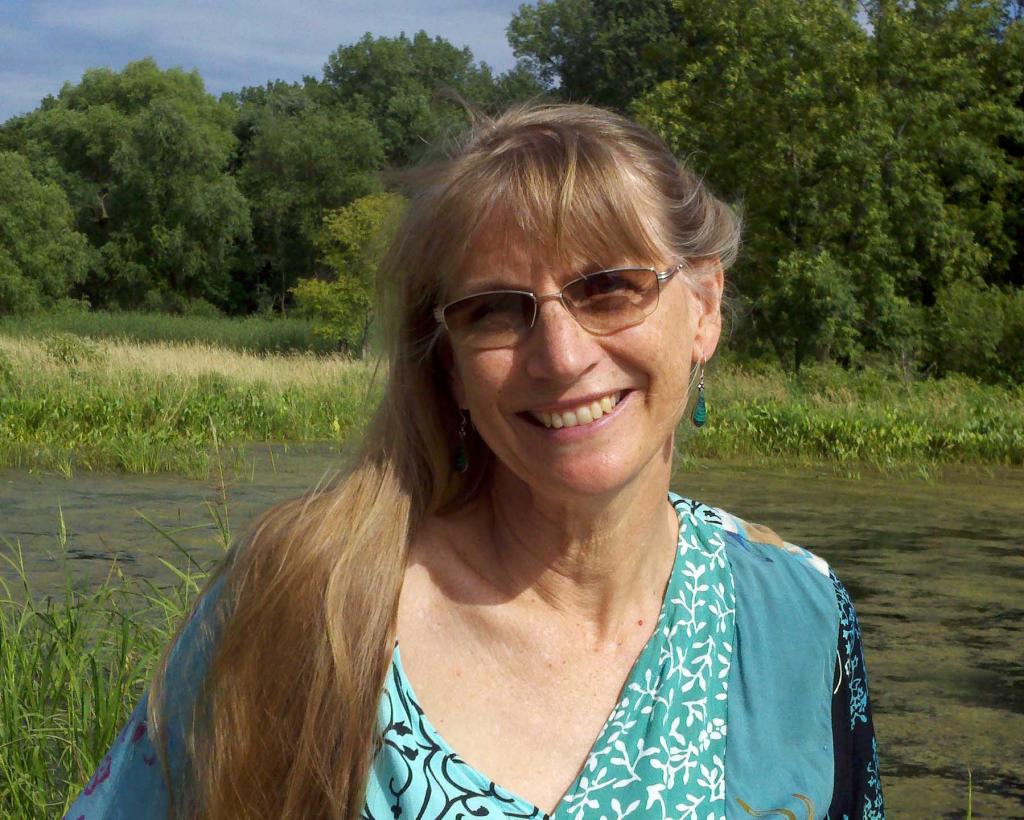
Joyce Maschinski
CPC President & CEOConserving Texas and Gulf Coast Flora with the CPC Plant Sponsorship Program
Mercer Botanic Gardens, a Harris County facility located in Humble, Texas, began endangered native plant conservation efforts around 1986 with the ex situ conservation (seed banking and propagation) of a local federally listed species, Texas prairie dawn, Hymenoxys texana (Asteraceae). Mercer became a Participating Institution of the Center for Plant Conservation (CPC) in 1989 under the guidance of Dr. Kathryn Kennedy, former US Fish and Wildlife Service (USFWS) botanist in Texas and former CPC President. At that time, San Antonio Botanical Garden (SABG) in south Texas served as the only CPC institution in the state. Once Mercer joined CPC, SABG – long-time partners of Mercer’s – transferred two federally listed East Texas species from their responsibility to Mercer’s. The Quaker Hill Foundation sponsored large-fruited sand verbena (Abronia macrocarpa) in 1990. Thanks to donations from Houston families (Dr. and Mrs. Sellers J. Thomas, Jr.; Mr. Frank A. Liddel, Jr.; Dr. and Mrs. Charles F. Squire) and the USFWS, white bladderpod (Physaria pallida) reached full sponsorship in 1999. Mercer’s research work continues in close partnership with our Texas CPC partners (SABG; Lady Bird Johnson Wildflower Center, University of Texas, Austin; and the Botanical Research Institute of Texas/Fort Worth Botanic Garden), as well as the out-of-state CPC network and governmental, academic, and non-profit partners.
I began my service as Mercer’s botanist and conservation manager in 2000. With CPC sponsorship stipends helping to fund expenses such as equipment, horticultural supplies, and travel costs for seed collections and field work, it made sense to me that sponsoring plants in the National Collection would help sustain Mercer’s native plant conservation program. Texas trailing phlox (Phlox nivalis spp. texensis), a beautiful, federally listed ‘Big Thicket’ Texas species, seemed like a perfect candidate for sponsorship. Mercer seed banks this species, assists reintroductions, and maintains educational displays in our Endangered Species and Native Plant Garden. Sponsorship was completed in 2003 by The River Oaks Garden Club; The Mercer Society’s ‘Mercer Memorial Trust Fund’; Mercer Volunteer Native Plant Team chairpersons, the late David C. Berkshire and Carol Kobb (in memory of her friend Millie Guadino); Mercer colleague and CPC ‘Conservation Champion’ Suzzanne Chapman in honor of her parents, Ann C. Baumer and Derek Chapman; and myself, in memory of my parents, Ruth L. and Werner G. Tiller.
As part of our service to Harris County, staff provide tours and lectures about the benefits of native plants and Mercer’s role in plant conservation. Our plant sponsorship donors include the garden clubs, members of the Texas Master Gardener, Naturalist, and Native Plant Society organizations that attend our lectures and tours. Donors include private individuals, nature-based organizations, volunteers, and sponsors recruited by the CPC National Office. Plant sponsorship donations often serve as memorials, and volunteers are among our most dedicated donors. The Gibson family—retired volunteers who worked alongside Suzzanne Chapman—completed full sponsorship of Texas windmill grass (Chloris texensis) in 2019 and Louisiana quillwort (Isoetes louisianensis) in 2020, and hope to complete the sponsorship of Scarlet catchfly, Silene subciliata (Caryophyllaceae) this year.


Our plant sponsorship efforts would not be possible without the support of Harris County staff and our non-profit arm, The Mercer Society. Harris County staff produced the educational brochure ‘Preserving Imperiled Plants’ and interpretive signage for Mercer’s Endangered Species and Native Plant Garden, and expanded our website to include a Plant Conservation section with links to CPC species profiles. These educational tools feature color images of National Collection species, acknowledge sponsorship donors, and help communicate the need to support rare and native plant conservation. Volunteer citizen scientists also provide integral support to Mercer’s native plant conservation and botany programs, including our curatorial, collections database, herbarium, library, garden signage and internship programs.
Mercer currently maintains 29 National Collection species with 10 fully and 5 partially sponsored species. Ongoing in situ projects include the management of naturally occurring populations of four rare saline prairie National Collection species at the Harris County Prairie Dawn Preserve. This tiny, less-than-4-acre preserve, located within Houston’s urban sprawl, was constructed in 2012-2013 and already shows promise. Texas prairie dawn and rare associate species are part of over 200 native species sheltered there. The preserve’s Texas windmill grass population currently represents the largest known population of this rare endemic.
This year, Mercer will propose additional vulnerable southeast Texas species for the National Collection. We thank the CPC Plant Sponsorship program for providing support to our efforts for the conservation of Texas and Gulf Coast flora. Through this funding, the CPC is helping Mercer fulfill its mission ‘to improve the quality of life and inspire the greater appreciation of the essential value and beauty of the plant world’ for the thousands of children and adults that tour our gardens and facilities and attend our programs.
-

Louisiana quillwort (Isoetes louisianensis), a federally listed species ranked globally as G2, is native to Louisiana, Mississippi, and Alabama. Mercer propagated the plant material for a reintroduction to Abita Creek, Louisiana in 2008. The Louisiana quillwort plants had been rescued in 2001 from a nearby bridge construction site. Mercer Botanic Gardens, Endangered Species and Native Plant Garden. Photo by Suzzanne Chapman. -

Anita Tiller and Mercer Botanical Center intern Ella Matsuda monitoring Texas prairie dawn at the Harris County Prairie Dawn Preserve, March 9, 2020. Photo by Suzzanne Chapman. -

Anita Tiller with CPC Board members at the Harris County Prairie Dawn Preserve on September 27, 2014. Surrounded by industry in Houston, Texas, this less than 4-acre prairie remnant shelters naturally occurring populations of four rare saline prairie endemics (National Collection species) with ~200 additional native plant species. Photo by Suzzanne Chapman.
Conserving the Biodiversity of the Pacific Northwest
Rae Selling Berry Seed Bank & Plant Conservation Program (RSBSB) seeks to conserve the genetics of Oregon’s native plants for current and future generations. We are the primary off-site conservator of genetic resources of Oregon native plants, ensuring the survival of threatened species and the availability of appropriate seeds for restoring Pacific Northwest ecosystems. We support plant conservation regionally, nationally, and globally, with a focus on habitat-based efforts in Oregon and the region.
RSBSB began in 1983 as the Berry Botanic Garden Seed Bank for Rare and Endangered Species of the Pacific Northwest, the first seed bank in the country dedicated exclusively to endangered species. When the Berry Botanic Garden closed in 2011, its seed bank and conservation program joined Portland State University’s School of the Environment as a self-supporting program in the Department of Environmental Science and Management. Dr. Ed Guerrant (PhD, Botany) was Director of the Seed Bank between 1989 and 2018, and Dr. Gabriel Campbell became the most recent Director of the Seed Bank in January 2022.

Our primary conservation activities include seed processing and long-term storage; research to determine germination requirements and viability of seeds; and coordinating interns and volunteers to monitor plant populations, collect data, and collect and process seeds. We hold more than 23,000 seed accessions, representing close to 400 of our region’s rarest and most vulnerable plants. These serve as an insurance policy against local extinction events—a serious possibility for many endangered plants. We also hold over 100 accessions from common species of Oregon. Seeds are held primarily for use in reintroduction of plant populations to suitable habitat, research, and restoration projects. Seed storage is central and crucial to our mission.
RSBSB stewards 148 rare plant species in the Center for Plant Conservation’s (CPC) National Collection, 28 of which are sponsored through the CPC Plant Sponsorship program. This program has helped grow our seed bank by providing direct financial support for various aspects of our conservation work.
While the majority of our CPC-sponsored rare plant species are dormant seeds, RSBSB also conducts conservation activities with some live plants, such as the western lily (Lilium occidentale), a federal and state (OR and CA) listed endangered species. Around half of the known populations have been extirpated, especially those near the center of its narrow range along the Pacific Coast, straddling the CA/OR border. With a stunningly beautiful flower, it’s no surprise that horticultural collecting and flower picking are among the greatest threats to this species, as well as land development, agricultural conversion, and soil compaction.
To protect the western lily, RSBSB has conducted a long-standing conservation program in three study sites that encompass all known western lily plants on federal land. The first monitors a reintroduction project initiated in 1996, when there were no known populations on federal land. Another monitors the demographics of a small, naturally occurring population discovered on federal land in 2008, and the third monitors a 2015 population augmentation.
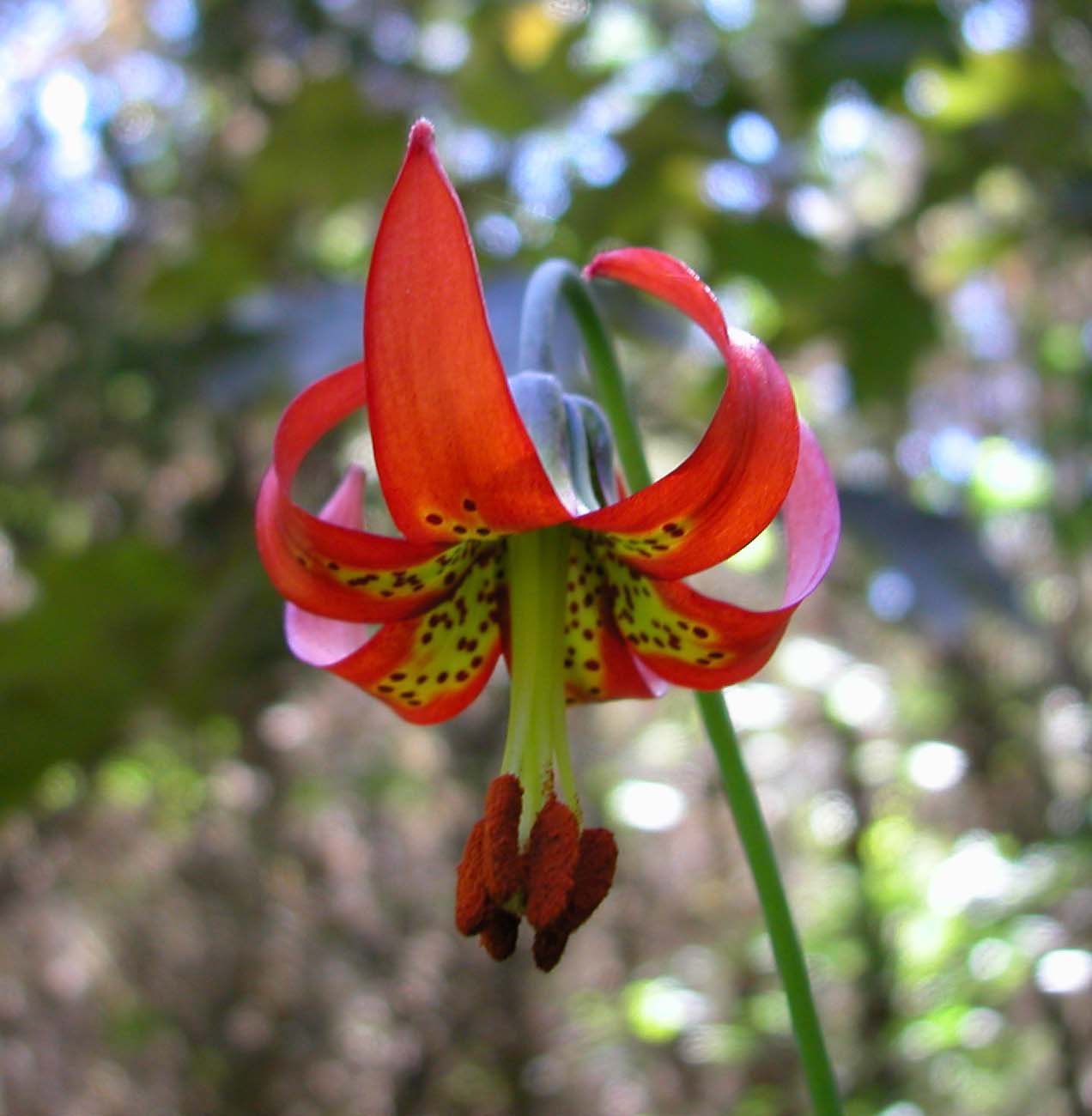
The 1996 reintroduction was designed to test two management hypotheses: does propagule type (small plants, new seed, or old seed) and/or removal of ground cover at planting time affect establishment and subsequent plant survival and growth rate? An initial sample of 760 propagules was outplanted, mapped and marked. Data are gathered annually on leaf area, number of leaves, and number of flowers; herbivory is also noted and categorized. To date, we have found that propagule type does have a long-term impact, but initial removal of ground cover does not.
Discovery of a small, naturally occurring population of 16 western lilies in 2008 spurred RSBSB to begin a demographic study, and to search the surroundings for more plants and appropriate habitat. We surveyed an area containing the entire population, constructed a one-meter grid, generated a three-dimensional vegetation map, and installed two wells to measure ground water levels over time. We mapped and marked all western lily plants in the site to allow us to follow size and status of individual plants over time. In the fall of 2015, we also began an experimental augmentation to increase numbers of this species, further enhancing recovery.

This year marks the 26th year of our reintroduction of this special lily. There is something very satisfying about studying a place over many years, appreciating how it both changes and stays the same. An ongoing contract with the Bureau of Land Management has funded the monitoring of these sites for over two decades. The CPC Plant Sponsorship program supports our work to maintain and supplement a source of viable Lilium occidentale seeds, one of the many essential tasks of RSBSB’s conservation program. Our in situ work is grounded in a healthy and substantial collection of genetic material and the efforts and expertise of properly recompensed staff.
While RSBSB is known and valued globally for our support of regional biodiversity and contributions to other plant conservation programs, our work is of greatest value to the Pacific Northwest. As we evolve to meet new and increasing conservation threats, we find ourselves concentrating more and more on our home state. Our focus—our passion—is to pass the abundant biodiversity we have inherited forward to future generations.
Supporting Lyon’s Hawaiian Rare Plant Program
In the public imagination, Hawai’i is a beach-lined tropical paradise, with nary a thought given to the diversity of habitats on each of the islands. But the staff of Lyon Arboretum are acutely aware of this diversity as they work to grow rare plants from across Oah’u and the other islands. Special care is needed for dry forest or coastal species that might not be used to the 140 inches of rain per year and cloud cover of Mānoa Valley or the lack of a true winter to kill off nonnative pests and pathogens. Despite these challenges, Timothy Kroessig, Horticulture Manager at Lyon Arboretum, and his team provide excellent care to over 100 species in the CPC National Collection.
It helps that 16 of the National Collection species are sponsored. The dependable annual support from these sponsorships helps the Arboretum provide care and cover operational costs of facilities for the ex situ collections. The Arboretum maintains a Micropropagation Lab, Seed Conservation Lab, and Hawaiian Rare Plant Nursery as part of their Hawaiian Rare Plant Program (HRPP). With over 200 species on the brink of extinction (50 individuals or fewer in the wild), there is no shortage of species in need. The amount and type of material brought in, as well as the species biology and future conservation plans, all determine whether a species is conserved as a seed, tissue culture, or living collection. Some species, such as Diamond Head schiedea (Schiedea adamantis), are conserved in all three collection types: 300,000+ seeds, ~150 explants in culture, and 12 plants in the nursery.
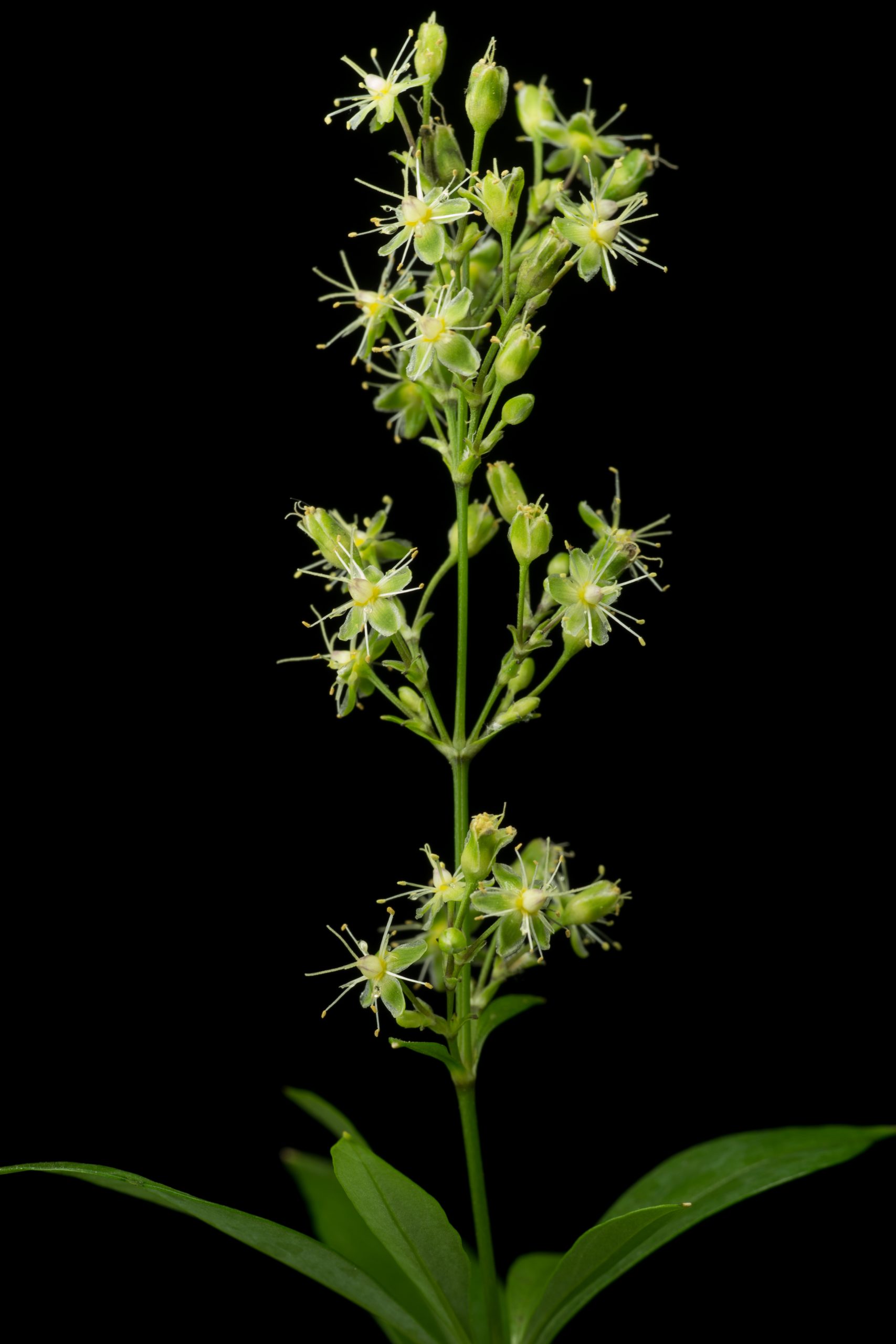
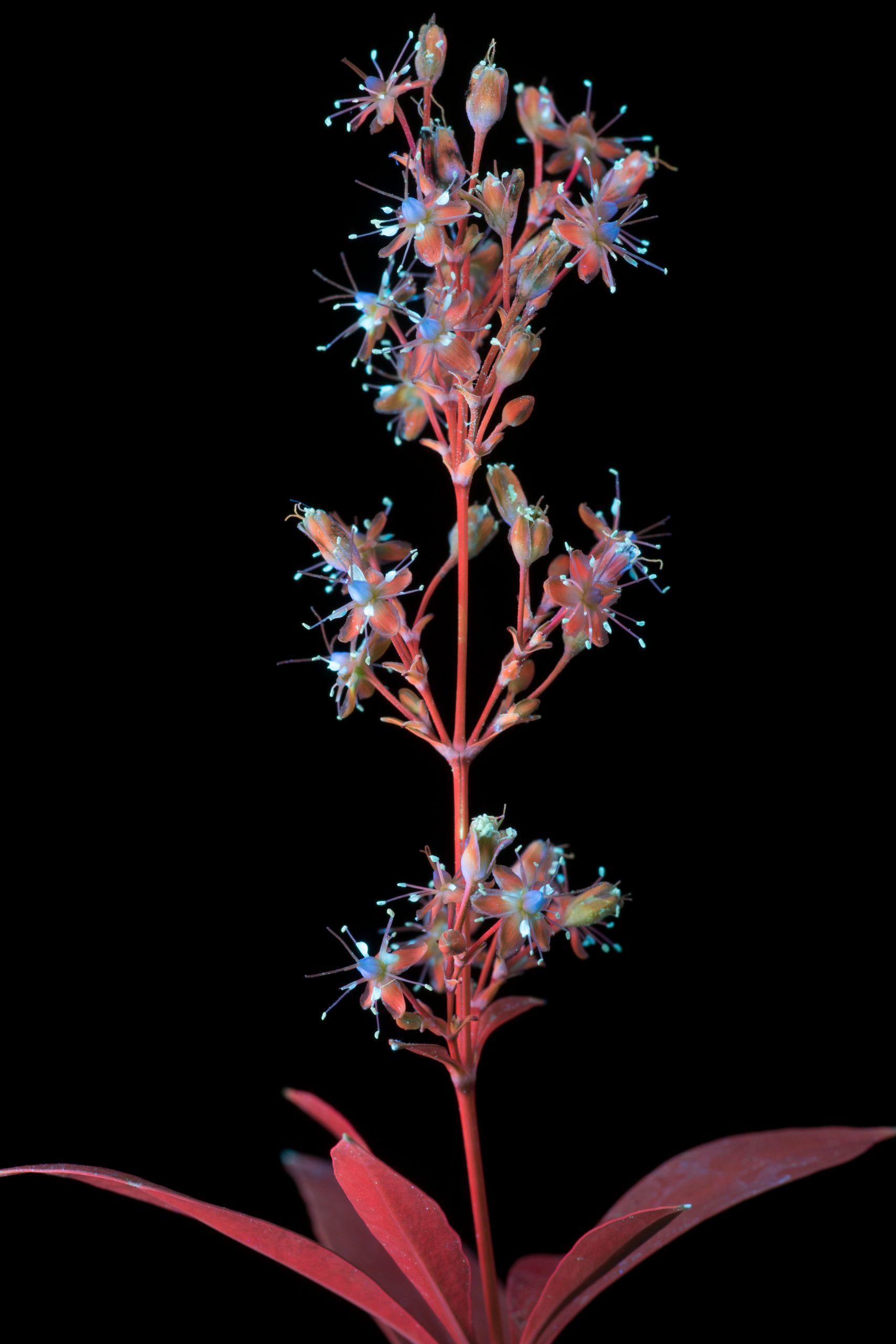
Diamond Head schiedea is a CPC Sponsored species. It was brought into Lyon’s Hawaiian Rare Plant Program over 20 years ago by a partner, like many of Lyon’s collections. In this case, staff from the Plant Extinction Prevention Program (PEPP, known at that time as the Hawaii Genetic Safety Net Program) brought seed from one of only two remaining sites. Because the collections were made decades ago, the Lyon collections hold valuable genetic diversity that is no longer present in the wild populations, which have dwindled to only a few dozen plants. The collections act as a safeguard against extinction, should anything happen to one or both of the wild populations. They also provide source material for propagation and restoration efforts carried out by Lyon’s partner organizations.
Timothy stresses that Lyon Arboretum program is focused on maintaining Diamond Head schiedea and its other National Collection species in ex situ collections, where their expertise lies — but they know that these collections are only a part of the solution. HRPP team members develop protocols for both maintenance and propagation, balancing the need to learn from the collections with the urgency of minimizing risk to this extremely valuable and limited plant material. They also face the challenge of planning for how and when to eventually withdraw plants from the collections for use in restoration or the regeneration of other collections. Lyon works with partners, especially PEPP and Hawaii’s Division of Forestry and Wildlife, to determine recollection and restoration needs.
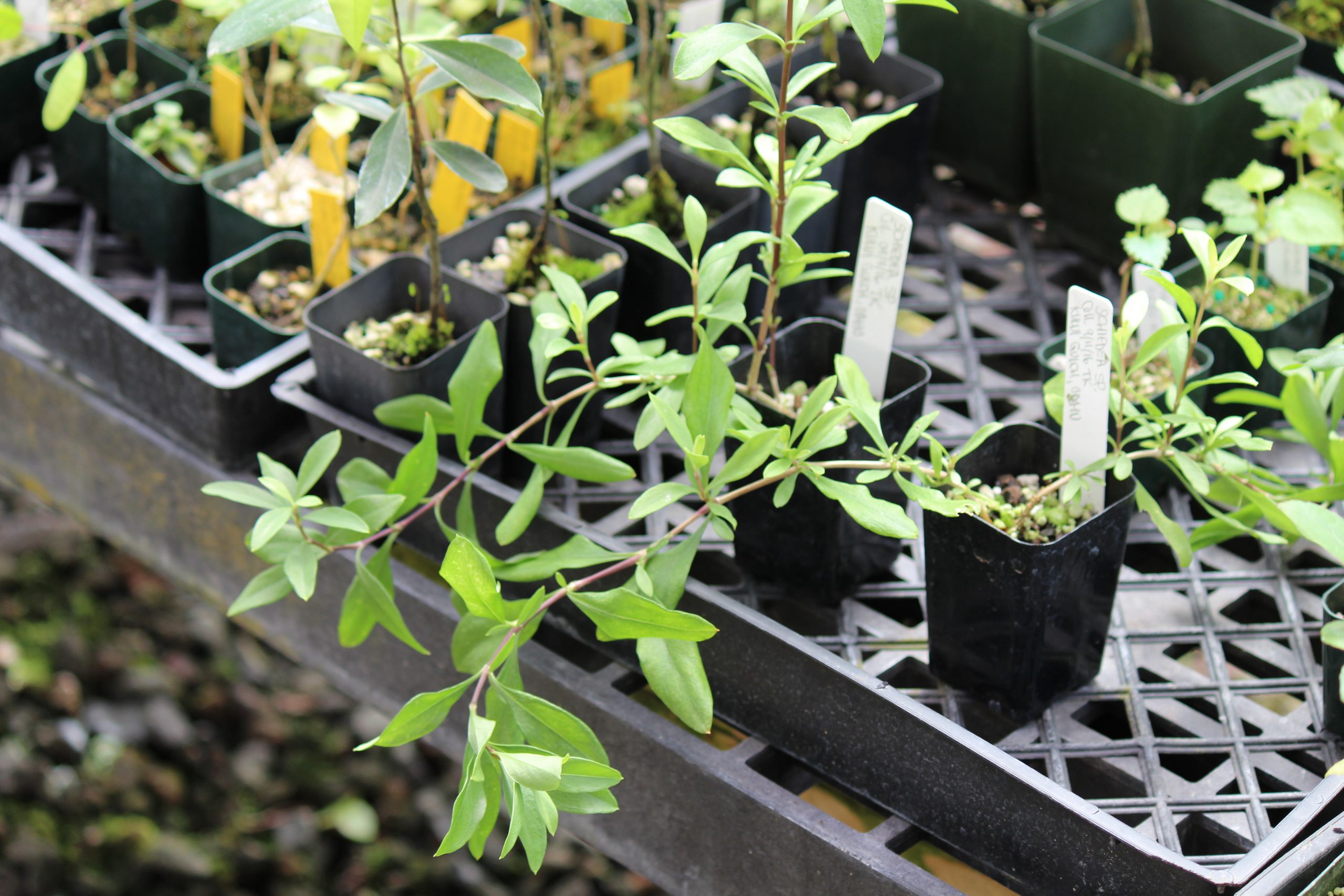

For some of these species, protected and managed habitat is simply not available to support reintroduction into the wild. And greenhouse space is limited. But there is another option for living plants – Lyon Arboretum has been expanding the use of its grounds to support rare Hawaiian plants. They are using the Arboretum to establish inter situ collections, collections that are maintained and managed outside of a species habitat. Baker’s loulu (Pritchardia bakeri), a National Collection species available for sponsorship, is a candidate for an inter situ collection. This species, one of the few palms native to Hawaii, is named for the late head groundskeeper of the Arboretum, Ray Baker. Lyon is working with PEPP to secure material from each of the remaining wild populations for conservation plantings on grounds. A sponsorship for Baker’s loulu would help the team carry out more collection trips, propagate plants in the greenhouse, and establish this important inter situ collection.
While that project develops, Timothy has plenty to do in the nursery, and so do the teams in the micropropagation lab, seed bank, and on the grounds. Maintaining National Collection species, sponsored and unsponsored, is a never-ending job in Hawai’i. Every little bit helps, and having even 16% of their National Collections species sponsored has helped Lyon ensure that more of Hawaii’s rare plants will be here in the future.
-

Diamond Head schiedea (Schiedea adamantis) was added to the Lyon HRPP ex-situ collection more than two decades ago (2001) through seed collection efforts by the Hawaii Genetic Safety Net Program, which is now known as the Plant Extinction Prevention Program. Photo by Timothy Kroessig, Lyon Arboretum. -
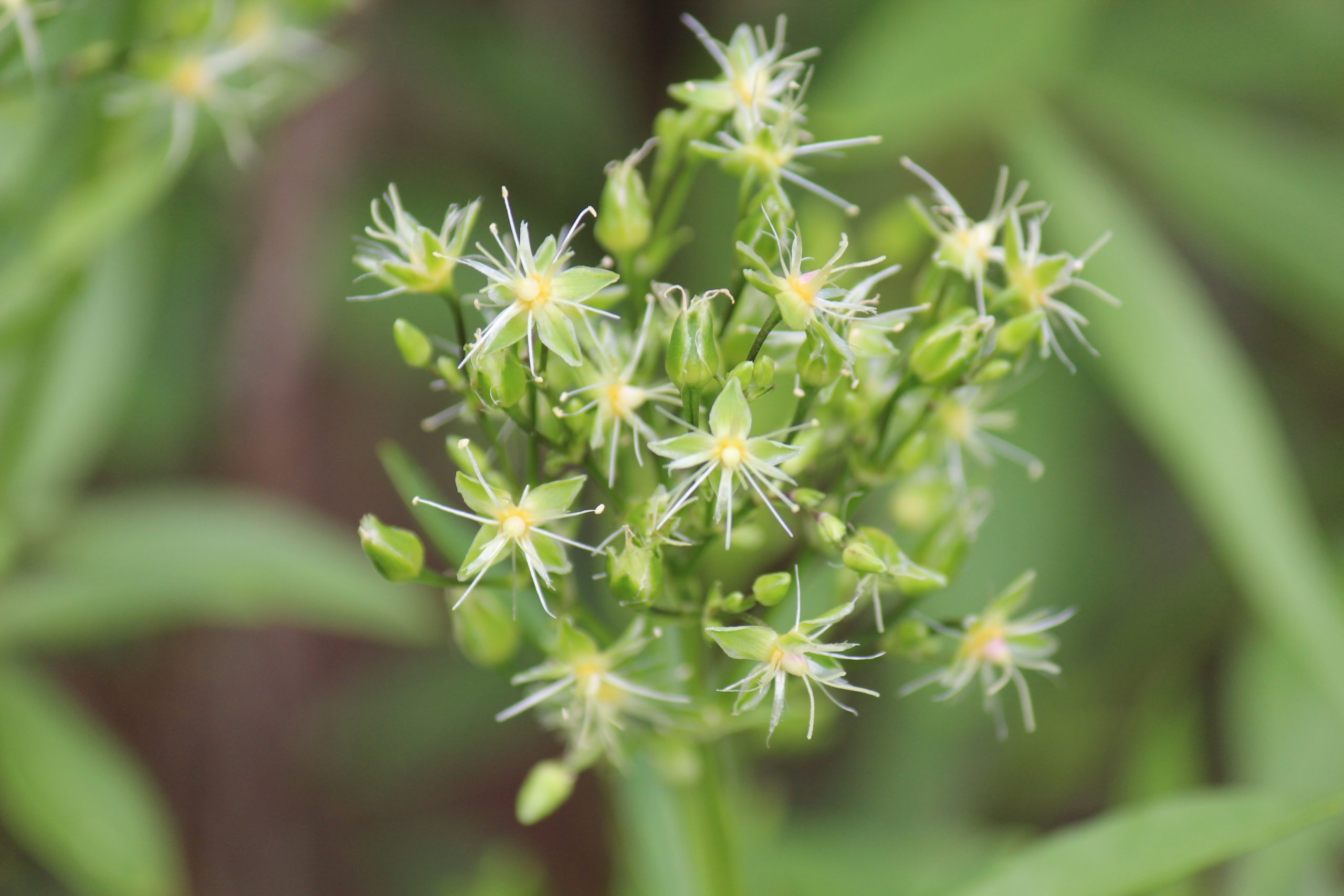
Lyon Arboretum's ex-situ collections act as a resource for propagation and restoration efforts carried out by our partner organizations who are activity working to restore these threatened species in protected habitats across the State of Hawaii. Learning to care for the species and getting them to flower and reproduce (like the Diamond Head schiedea here) is part of the care supported by sponsoship. Photo by Timothy Kroessig, Lyon Arboretum. -
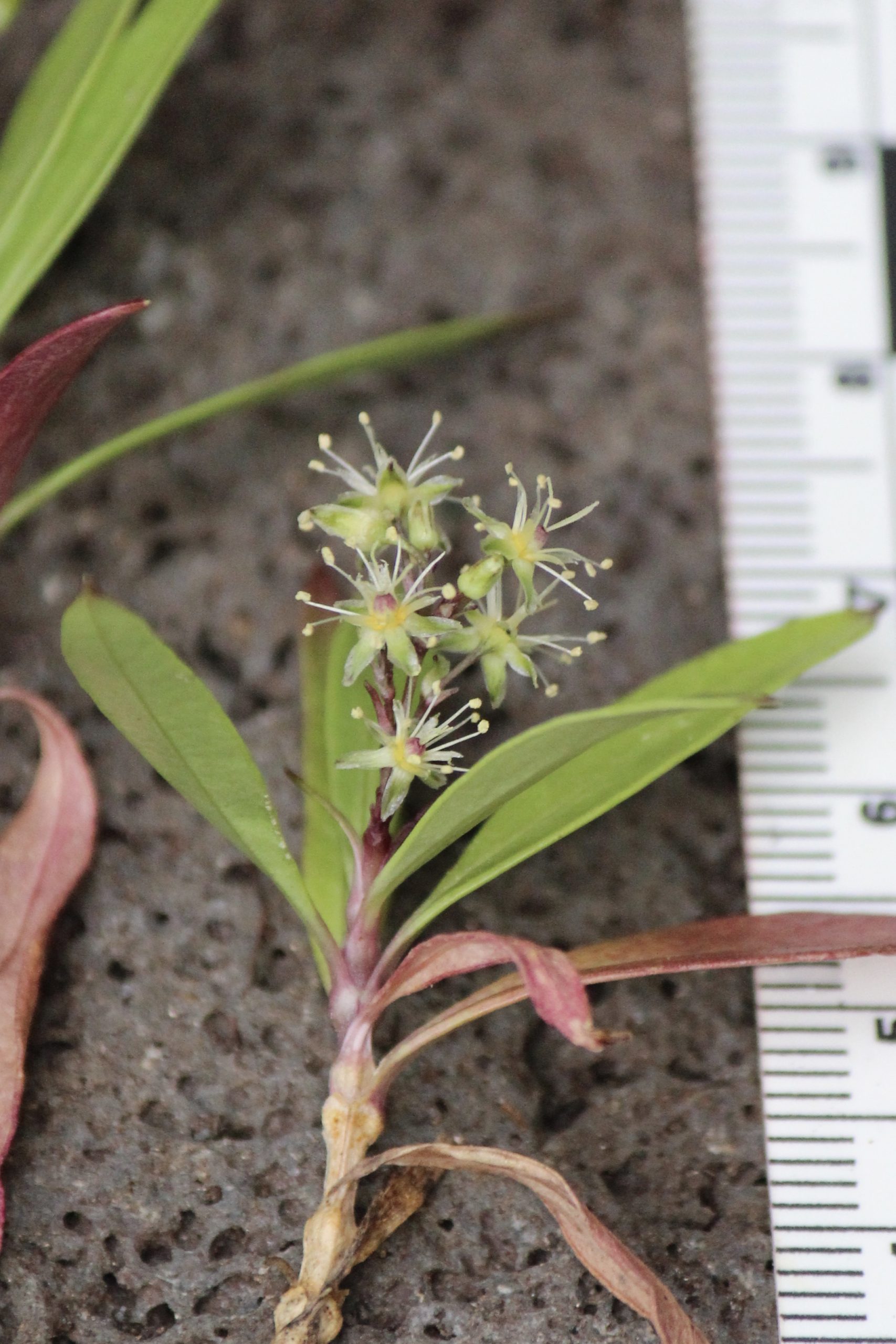
Close up view of Diamond Head schiedea (Schiedea adamantis). Photo by Timothy Kroessig, Lyon Arboretum. -
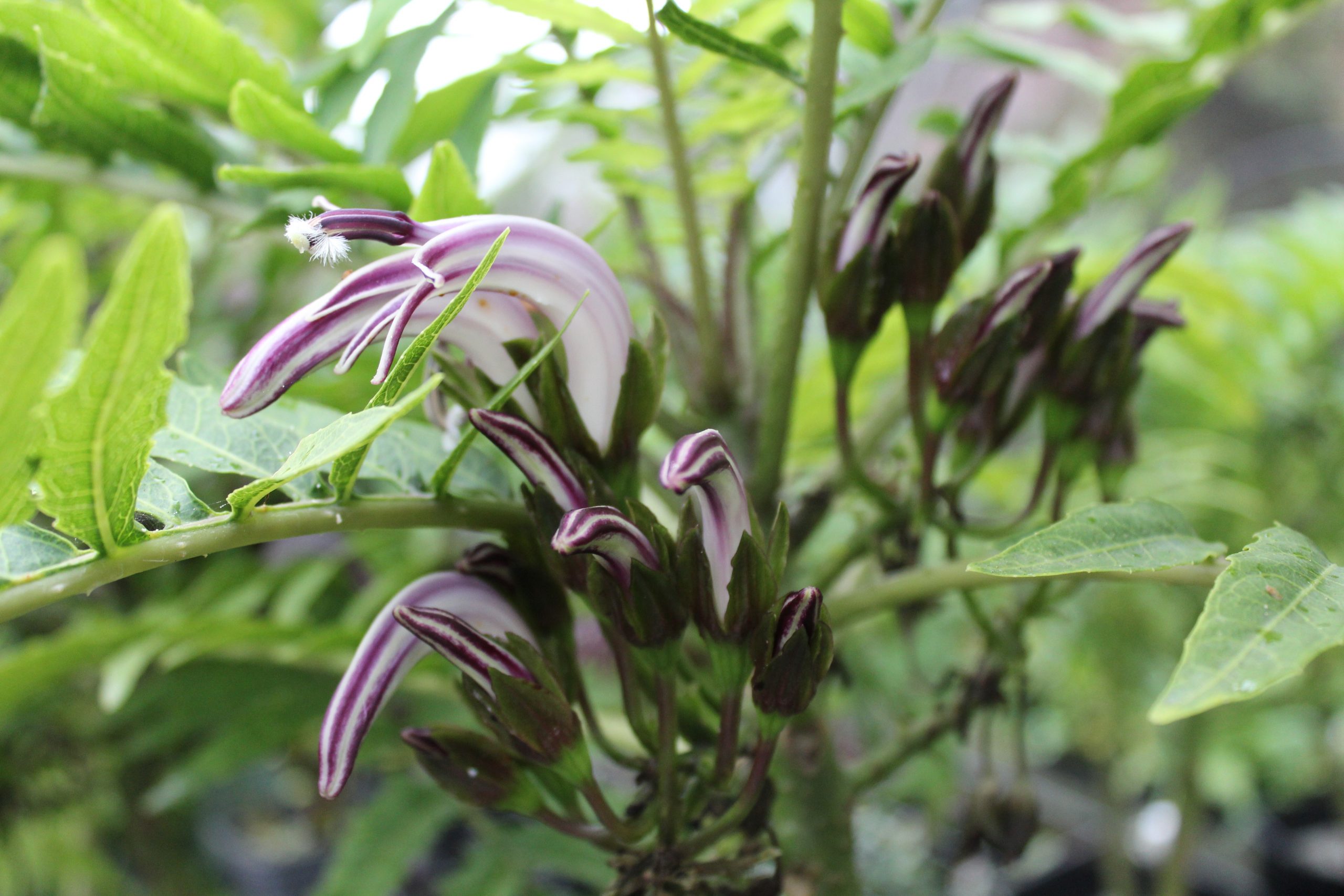
Flowering Cyanea grimesiana subsp. grimesiana in the nursery at Lyon Arboretum. -

Pritchardia bakeri inter situ. Photo by Timothy Kroessig -
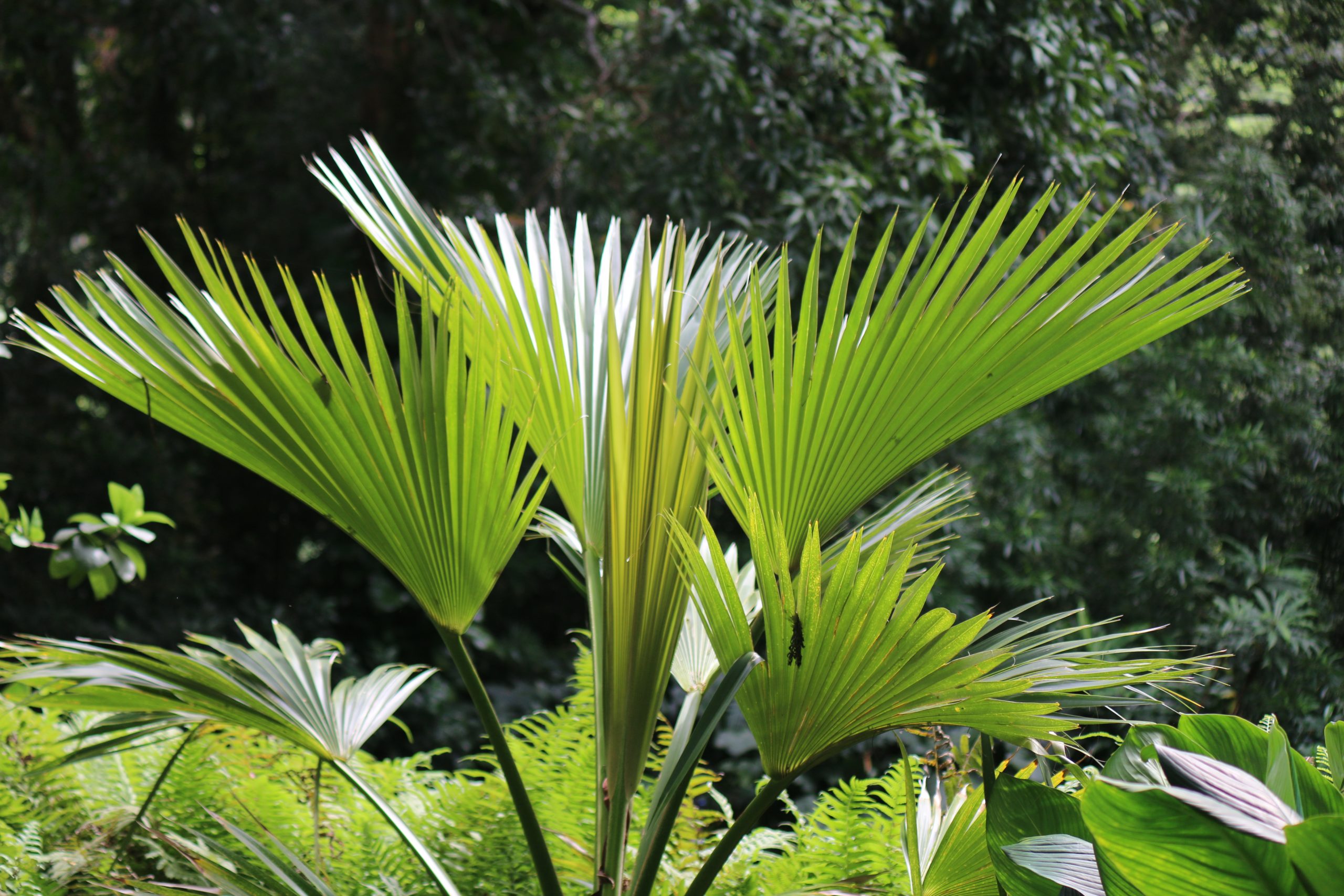
Pritchardia bakeri inter situ. Photo by Timothy Kroessig
Andy Love
If ever asked, “Why save plants?” Andy Love waxes eloquent about the self-evident importance of plant conservation for human well-being. A stalwart conservationist, Andy has served on the CPC Board of Trustees managing our investments and personally supporting plant sponsorships for more than two decades. He understands the resources PIs devote to steward rare plants. Desiring to do more, Andy recently inspired us to introduce new premium levels of sponsorship. Our National Collection plants, PIs, and the National Office all benefit from Andy’s devotion to CPC.
“Our Foundation found the idea of fully sponsoring all of the Missouri rare plants appealing. Our Foundation focuses on Missouri flora (as well as fauna). We appreciate that plant sponsorship provides an immediate benefit to the sponsored plants and their host institutions (in our case mostly Missouri Botanical Garden). As funds from sponsorships and their earnings grow over time, they contribute to the more general plant conservation work of the CPC for both the particular sponsored plants as well as for all of the endangered species in the National Collection.” – Andy Love
Mr. Love was Chairman, Co-CEO and a principal owner of Love Savings Holding Company prior to the merger of it and its subsidiaries, Heartland Bank and Love Funding Corporation, with Midland States Bancorp. He is currently Chairman and Co-CEO of Hallmark Investment Corporation and a manager of its subsidiary, Allegro Senior Living, LLC. Mr. Love has over 40 years of experience in real estate and finance. Formerly, he was a partner at the St. Louis law firm of Bryan, Cave, McPheeters, and McRoberts. He has served as a board member of many charitable organizations, including the St. Louis Symphony Society, St. Louis Country Day School, St. Louis Repertory Theatre, the Missouri Chapter of the Nature Conservancy, Webster University, the Edward K. Love Conservation Foundation and the Martha Love Symington Charitable Foundation / Love Family Charitable Trust. Mr. Love received an A.B. degree from Harvard College and an LL.B. degree from the Harvard Law School.
The Center for Plant Conservation to Receive Distinguished Service Medal From the Garden Club of America

The Center for Plant Conservation’s staff and Board of Trustees are thrilled to share that the Garden Club of America has announced that its Distinguished Service Medal, awarded for distinguished service in the field of horticulture, will be presented to the Center for Plant Conservation for its notable work in saving the nation’s endangered plants from extinction.
From the Garden Club of America:
The Center for Plant Conservation (CPC) is a unique network of over sixty world-class botanical institutions that collaboratively work to save the imperiled plants of North America. Founded in 1984 in Boston at The Arnold Arboretum of Harvard University, CPC began working with eighteen botanical gardens and arboreta, with a mission to save the endangered plants of the United States.
CPC works with scientists around the world to advance and share best practices in saving plants from extinction. Plants are protected in situ (protecting the natural habitat), and ex situ (in greenhouses, display gardens, seed banks, and laboratories). Of the 4,400 rare and endangered plant species in North America, one-half are in the CPC National Collection of Endangered Plants, with a goal of doubling the number in the next three years.
CPC safeguards rare plants by advancing science-based conservation practices, connecting and empowering plant conservationists, and inspiring all to protect biodiversity for future generations.
The Distinguished Service Medal will be awarded to CPC at the Garden Club of America’s annual national meeting in April 2022.
National Collection Spotlight: Colorado Hookless Cactus (Sclerocactus glaucus)
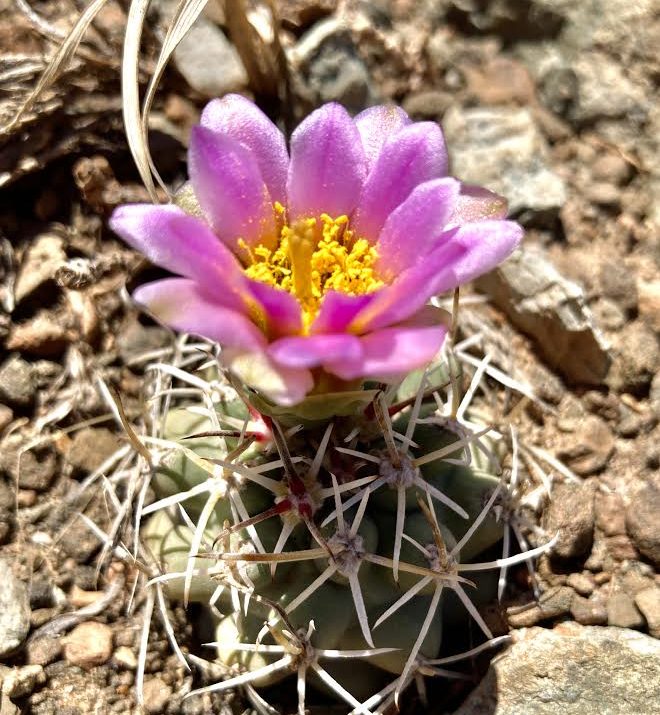
The Colorado hookless cactus (Sclerocactus glaucus) can be difficult to find in the river alluvium habitat it calls home in western Colorado and eastern Utah; the perennial stem can be inconspicuous in the coarse gravel – and even shrink below the ground during large stretches of the year – making these plants difficult to spot and identify when not in bloom. Fortunately, this federally threatened cactus produces striking pink flowers which bloom from April to May.
Nearly all populations are threatened with habitat destruction or modification from energy extraction developments, water storage projects, transportation, and residential facilities. Other ongoing threats include impacts from moss-rock and rip-rap collecting operations, illegal plant collection, and damage from recreational use or livestock trampling. Denver Botanic Gardens maintains a seed collection and has established macroplots of Colorado Hookless cactus populations to monitor demographic trends as part of its conservation efforts to save this species from extinction.
Learn more about the Colorado hookless cactus on its National Collection Plant Profile and support its conservation with a Plant Sponsorship.
Sponsor a Plant, Save a Plant
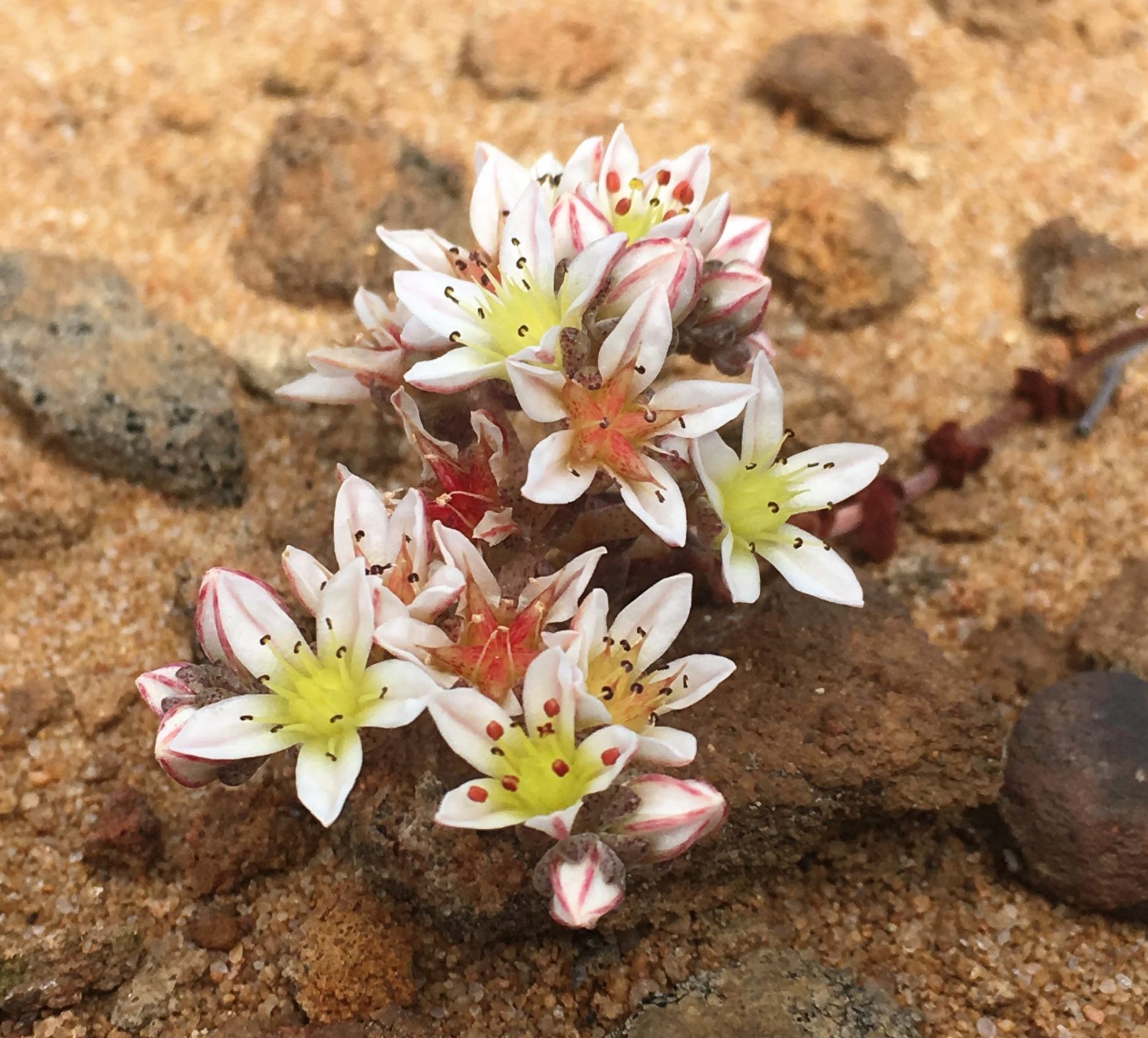
This February, we invite you to show your love by sponsoring some of the incredible plants in the CPC National Collection of Endangered Species. Throughout the month, we’ll be sharing stories of four special plant species in the National Collection – including Shortleaf dudleya (Dudleya brevifolia) – and how you can help save them from extinction by supporting the Plant Sponsorship program.
Plant sponsorships create an annual, stable stipend to cover some of the expenses of collecting seed, growing the plants, and conducting conservation research. Your gift toward a plant sponsorship plays an essential role in CPC’s mission to Save Plants.
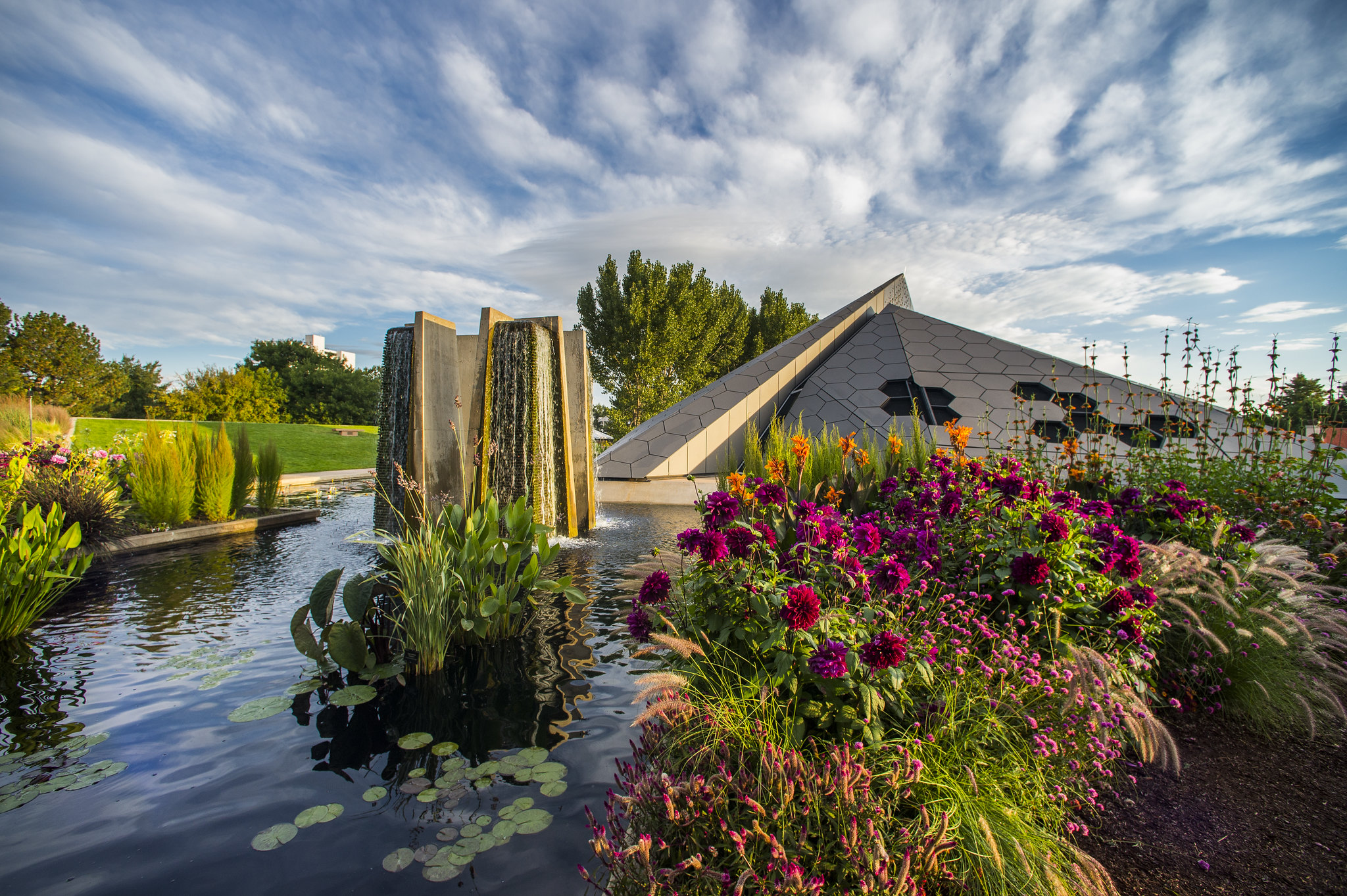
2022 CPC National Meeting
May 4-6, 2022
Registration is now live for the 2022 CPC National Meeting – our first-ever hybrid meeting! The theme of this year’s meeting will be “Celebrating Conservation Milestones,” with both in-person and online presentation sessions including updates from the CPC National Office on network-wide initiatives, plus lightning talks from CPC network partners on plant conservation research, accomplishments, and challenges. In-person sessions will be held at the Denver Botanic Gardens and will be live streamed and recorded for later viewing on the Whova conference platform used by the CPC National Office for our 2020 and 2021 virtual meetings. Virtual attendees will also have access to pre-recorded presentation content and virtual break out sessions.
Early bird registration is available through April 1 – register today to get the discounted rate!
As Seen on Rare Plant Academy:
Rare Plant Finder
Across North America there are over 4,000 rare and native plants in danger of becoming extinct. The Center for Plant Conservation harnesses the collective knowledge and expertise of our network of plant conservationists and botanical gardens to safeguard these imperiled plant species, to ensure they thrive for generations to come. We invite you to learn more about these plants using the Rare Plant Finder tool. Use the Rare Plant Finder to search the National Collection to discover which rare plants can be found in your area, find out which rare plants are in need of sponsorship, and view plant profiles to learn more about these beautiful, endangered plants. Search the Rare Plant Finder today!
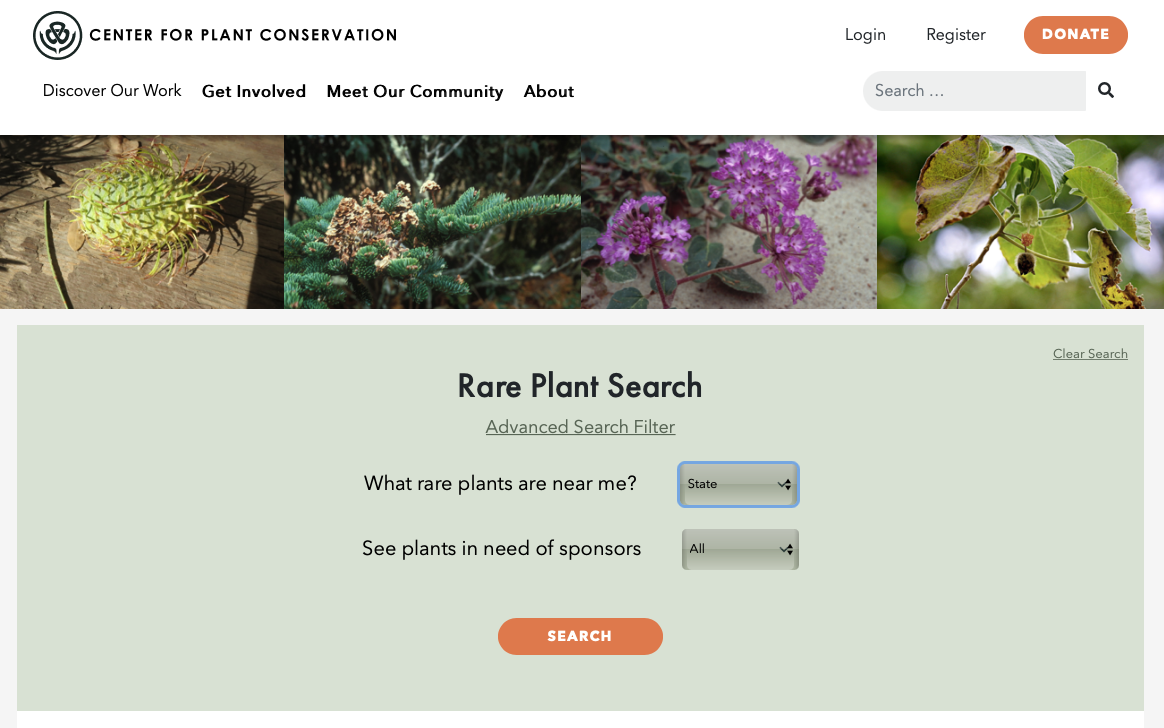
Get Updates
Get the latest news and conservation highlights from the CPC network by signing up for our newsletters.
Sign Up Today!Employment Opportunities
Natural Resources Specialist
Job Number: AID00435
Description
Akima Intra-Data (AID) is fiercely focused on innovation and continuous improvement. Our flexible, full-spectrum portfolio of base operations support services enables our customers to reduce operating costs, improve productivity and enhance the value of their existing assets. Our personnel enjoy competitive benefits packages and challenging roles in work environments committed to safety, diversity and opportunity for career growth. As an Alaska Native Corporation (ANC), 100% of our company’s profits go back to our more than 14,000 Iñupiat shareholders that have resided near and above the Arctic Circle for more than 10,000 years. Our business helps support their way of life and contributes to the survival of a culture that has thrived in a challenging environment.
Natural resources specialist team member responsible for management of flora and fauna on a 40,000 acre air force installation in Middle Tennessee.
Job duties:
- Provide technical expertise in restoration ecology, natural resource management, invasive species removal, and related disciplines
- Perform technical work including oversight of maintenance activities associated with restoration, monitoring and reporting for restoration projects on the ground, implementing restoration projects, providing input for landscape-level restoration planning, and site-specific design
- Perform botanical surveys, listed species surveys
- Participate in development of conservation plans, and habitat management plans
- Assist other biologists with natural resources field surveys including bat, snake, and bird surveys
- Multi-disciplinary teamwork with biologists and foresters
- Creative integration of natural resource analysis and project design
- Perform other related duties as required.
Minimum Qualifications:
- Must be a U.S. citizen to work on Arnold AFB
- Must be able to obtain a public trust security clearance
- Bachelor’s degree in botany, ecology, forestry or related field
- 1-3 years’ experience in a field related position
- Knowledge of native and non-native flora and experience identifying in field
- Experience in biological survey fieldwork, including vegetation monitoring
- You must be able to meet all health requirements, including but not limited to, current and future vaccination requirements for infectious diseases such as COVID-19.
Desired Qualifications:
- Basic skills in ArcGIS as well as experience with GPS and electronic data collection
- Basic to intermediate skills in statistical analysis
- Experience completing Habitat Restoration Maintenance and Monitoring Reports, Monitoring Plans, Biological Assessments, and/or EIR/EIS sections
- Knowledge of major state and federal agencies (e.g., USFWS, TN Division of Natural Areas) and major regulatory frameworks (e.g., NEPA, ESA)
- Ability to maintain basic wildland fire fighting certification
The duties and responsibilities listed in this job description generally cover the nature and level of work being performed by individuals assigned to this position. This is not intended to be a complete list of all duties, responsibilities, and skills required. Subject to the terms of an applicable collective bargaining agreement, the company management reserves the right to modify, add, or remove duties and to assign other duties as may be necessary. We wish to thank all applicants for their interest and effort in applying for the position; however, only candidates selected for interviews will be contacted.
We are an equal opportunity employer. All applicants will receive consideration for employment, without regard to race, color, religion, creed, national origin, gender or gender-identity, age, marital status, sexual orientation, veteran status, disability, pregnancy or parental status, or any other basis prohibited by law.
For more details and to apply online.
2022

2022 Washington Botanical Symposium (online) registration open
University of Washington Botanic Gardens and the University of Washington Herbarium, Burke Museum, are pleased to announce the
2022 Washington Botanical Symposium (online)
Wednesday, March 2, 2022
9:00 am – 3:30pm
Co-hosted by University of Washington Botanic Gardens and the University of Washington Herbarium, Burke Museum
Program information available at: http://bit.ly/wabotanicalsymposium
or https://botanicgardens.uw.edu/education/adults/conferences-symposia/wa-botanical-symposium/
This program will be presented online as a Zoom webinar. Scholarships are available for students, service corps members, or anyone with need.
An extensive network of professional, academic, and amateur botanists are actively engaged in the conservation, management, and study of Washington’s diverse flora. Their expertise ranges from how best to manage biodiversity, to understanding climate change impacts on plant communities, to naming and classifying the flora’s rare, common, and invasive elements. Invited speakers and poster presentations will share new insights and discoveries about these topics and more. Participants from throughout Washington and adjacent areas will have the opportunity to exchange ideas with colleagues within and across disciplines.
Attendees are invited to present research posters and make announcements about related news and opportunities on the symposium website. Contributions may include video, text, and/or images.
Sponsor:
Washington Native Plant Society.
Supporters:
King County Noxious Weed Program
Parametrix
The Watershed Company
Washington State Department of Natural Resources, Natural Heritage Program
Friends:
AECOM
Washington State Noxious Weed Control Board
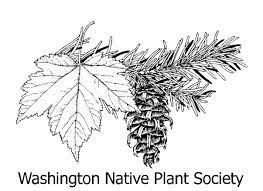
Washington Native Plant Society Conservation, Education, and Research Grants Available
The Washington Native Plant Society (WNPS) Conservation Committee is accepting grant application for projects that will restore, improve, or support on-the-ground, functioning native plant ecosystems in the State of Washington, USA. Successful projects must provide public benefit and must align with WNPS Conservation principles. Applications will be evaluated for the quantity and quality of ecological benefit to be gained and the likelihood of project long-term success. Grant applications will be accepted until midnight March 1 2022.
The WNPS Research and Education Committees are also accepting grant applications until midnight March 1 2022. For application information and contacts for each of these grant programs, see
https://www.wnps.org/conservation-grants
Ways to Help CPC

Support CPC By Using AmazonSmile
As many of us are now working from home and relying on home delivery more and more, we want to remind you that you can keep your home stocked AND Save Plants. If you plan to shop online, please consider using AmazonSmile.
AmazonSmile offers all of the same items, prices, and benefits of its sister website, Amazon.com, but with one distinct difference. When you shop on AmazonSmile, the AmazonSmile Foundation contributes 0.05 percent of eligible purchases to the charity of your choice. (Center for Plant Conservation).
There is no cost to charities or customers, and 100 percent of the donation generated from eligible purchases goes to the charity of your choice.
AmazonSmile is very simple to use—all you need is an Amazon account. On your first visit to the AmazonSmile site, you will be asked to log in to your Amazon account with existing username and password (you do not need a separate account for AmazonSmile). You will then be prompted to choose a charity to support. During future visits to the site, AmazonSmile will remember your charity and apply eligible purchases towards your total contribution—it is that easy!
If you do not have an Amazon account, you can create one on AmazonSmile.
Once you have selected Center for Plant Conservation as your charity, you are ready to start shopping. However, you must be logged into smile.amazon.com—donations will not be applied to purchases made on the Amazon.com main site or mobile app. It is also important to remember that not everything qualifies for AmazonSmile contributions.
So, stay safe inside, and when ordering online, remember you can still help save plants. Please feel free to share this email with your friends and family and ask them to select Center for Plant Conservation.
Thank you all for ALL you do.
Donate to CPC
Thank you for helping us save plant species facing extinction by making your gift to CPC through our secure donation portal!
Donate Today